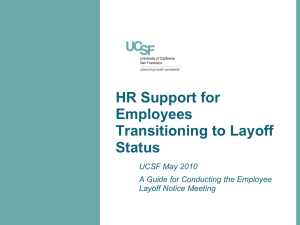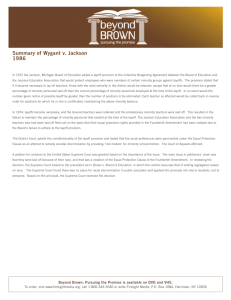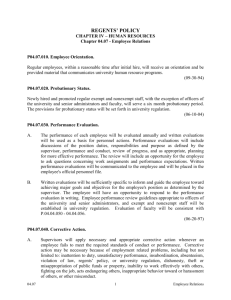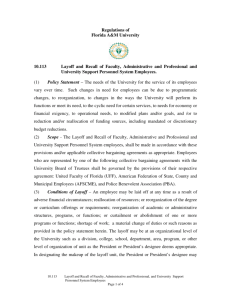Regents Policy 04-07 Employee Relations
advertisement
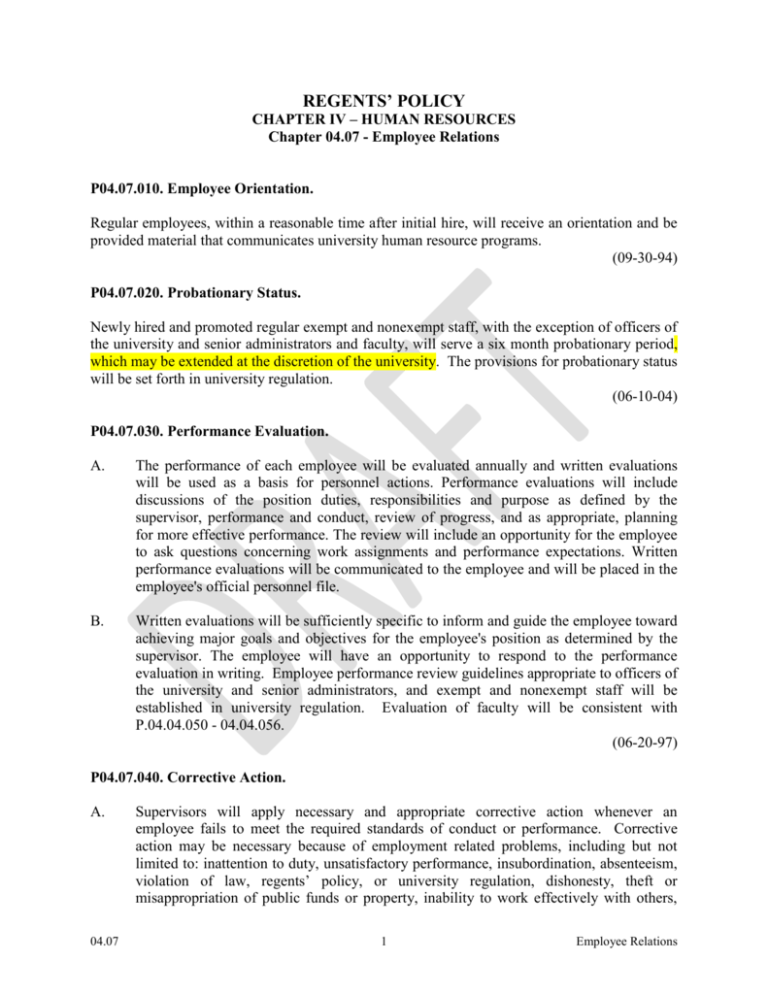
REGENTS’ POLICY CHAPTER IV – HUMAN RESOURCES Chapter 04.07 - Employee Relations P04.07.010. Employee Orientation. Regular employees, within a reasonable time after initial hire, will receive an orientation and be provided material that communicates university human resource programs. (09-30-94) P04.07.020. Probationary Status. Newly hired and promoted regular exempt and nonexempt staff, with the exception of officers of the university and senior administrators and faculty, will serve a six month probationary period, which may be extended at the discretion of the university. The provisions for probationary status will be set forth in university regulation. (06-10-04) P04.07.030. Performance Evaluation. A. The performance of each employee will be evaluated annually and written evaluations will be used as a basis for personnel actions. Performance evaluations will include discussions of the position duties, responsibilities and purpose as defined by the supervisor, performance and conduct, review of progress, and as appropriate, planning for more effective performance. The review will include an opportunity for the employee to ask questions concerning work assignments and performance expectations. Written performance evaluations will be communicated to the employee and will be placed in the employee's official personnel file. B. Written evaluations will be sufficiently specific to inform and guide the employee toward achieving major goals and objectives for the employee's position as determined by the supervisor. The employee will have an opportunity to respond to the performance evaluation in writing. Employee performance review guidelines appropriate to officers of the university and senior administrators, and exempt and nonexempt staff will be established in university regulation. Evaluation of faculty will be consistent with P.04.04.050 - 04.04.056. (06-20-97) P04.07.040. Corrective Action. A. 04.07 Supervisors will apply necessary and appropriate corrective action whenever an employee fails to meet the required standards of conduct or performance. Corrective action may be necessary because of employment related problems, including but not limited to: inattention to duty, unsatisfactory performance, insubordination, absenteeism, violation of law, regents’ policy, or university regulation, dishonesty, theft or misappropriation of public funds or property, inability to work effectively with others, 1 Employee Relations fighting on the job, acts endangering others, inappropriate behavior toward or harassment of others, bullying, or other misconduct. Proposed changes by Erik Seastedt B. Corrective actions may include: formal discussion, written communications detailing performance and behavior standards and expectations, written reprimands, which are sent to the official personnel file, disciplinary probation, suspension, dismissal, or any reasonable combination of these or other actions. (06-20-97) P04.07.041. Written Reprimand. A written reprimand will describe the nature of the offense or deficiency, the method or methods of correction, and the probable action to be taken if the offense is repeated or the deficiency persists. The written reprimand will be placed in the employee's official personnel file and also state the employee's right to request administrative review of the action by the MAU human resources office. (06-20-97) P04.07.042. Written Notice of Intent to Take Corrective Action. If corrective action more formal than written reprimand is necessary, notice of intent to take action will be given in writing to the MAU human resources office. If after consultation with the MAU human resources office the supervisor intends to take action, the employee will be notified in writing of the action to be taken. (06-20-97) P04.07.043. Disciplinary Probation. Any employee who fails to meet the performance standards or employment conditions of the supervising authority may, at the discretion of the supervisor, be placed on disciplinary probation for a period not exceeding six months. Failure to meet the performance standards or employment conditions of the supervising authority may result in termination of employment for cause. (06-20-97) P04.07.044. Suspension. A. Suspension without pay of not greater than 10 working days may be used in circumstances which the supervisor believes that by its use the employee will correct the employee's job related behavior or performance and where discharge appears unwarranted. B. The employee will be provided the reason for the suspension and the date and time to return to work in writing. The written notice will also state the employee's right to request administrative review of the action by the MAU human resources office. 04.07 2 Employee Relations C. A suspended employee will not receive holidays, wages, sick or annual leave accrual or other benefits based on hours worked during the leave period, but will continue to be covered by the applicable group insurance program. (06-20-97) P04.07.045. Investigatory Leave. After review by the MAU human resources office and concurrence of the Statewide Office of Human Resources, a supervisor may place an employee on paid investigatory leave without prior written warning in order to review or investigate allegations of serious misconduct of a nature which, at the discretion of the university, requires removing the employee from the premises. (06-20-97) P04.07.050. Administrative Review. A. To encourage and facilitate the resolution of employee complaints in a prompt manner, an individual may request administrative review of any complaint regarding a specific management action which adversely affects the employee's terms and conditions of employment. These complaints include, but are not limited to, those regarding: selection for transfer or promotion, release from at-will employment, salary actions, a performance evaluation, disciplinary probation and suspension. B. An employee who has a complaint will discuss it with the immediate supervisor who will have an opportunity to resolve the complaint informally. If the complaint is not resolved, the employee may request administrative review by the MAU human resources office. The director or designee may conduct a review, decline a review, or refer the matter to an administrative process. (06-20-97) P04.07.060. Termination for Cause. A. B. 04.07 Regular employees may be terminated from employment for cause. In the event of a decision to terminate an employee for cause, the supervisor will provide the employee: 1. a written statement of the reason for the planned action; 2. a statement of the evidence supporting the reason for the planned action; and 3. notice of the employee's right to request a hearing in accordance with the procedure for consideration of a termination for cause as set forth in the university grievance procedure in P04.08 and R04.08. Copies of the notification under A. of this section will be sent to the regional human resources office for placement in the official personnel file and to the offices of the general counsel and statewide human resources. (05-04-99) 3 Employee Relations P04.07.080. Resignation. The provisions for resignation will be set forth in university regulation. (06-20-97) P04.07.090. Retirement. A. The university will comply with applicable laws regarding age discrimination, including Alaska Statute 18.80.220. B. Retirement eligibility will be governed by the Public Employees Retirement System or Teachers Retirement System of the State of Alaska, or any applicable Optional Retirement Plan. (06-09-00) P04.07.100. Nonretention. The university may discontinue or not renew an existing employment relationship through nonretention. Nonretention does not reflect discredit on an employee. If notice of nonretention is required by university regulation, the notice will be in writing and will comply with university regulation adopted under this section. The university may not use nonretention to terminate tenured faculty. (06-09-00) P04.07.110. Layoff, Recall, and Release. Provisions regarding layoff, recall, and release of university employees will be set forth in university regulation. (06-09-00) P04.07.120. Exit Interviews. Prior to termination from employment, the department and the employee will contact the regional human resources office to receive information regarding university personnel human resources programs as appropriate; and the employee will be given the opportunity to communicate in writing any comments or suggestions for improvement within the workplace. (09-30-94) 04.07 4 Employee Relations UNIVERSITY REGULATION PART IV - HUMAN RESOURCES Chapter 04.07 - Employee Relations R04.07.010. Employee Orientation. In a combination of regional personnel human resources services and departmental orientations, new employees will be apprised of University of Alaska personnel human resources programs, policy and regulation, and other general workplace information. The Statewide Office of Human Resources will provide a list of topics which must be covered in orientation. Regional personnel human resources offices and departments will augment the list with additional information relevant to individual campus and department processes and procedures. (09-30-94) R04.07.020. Probationary Status. A. Newly hired regular exempt and nonexempt staff will serve a 6-month probationary period, which may be extended at the sole discretion of the supervisor. The probationary period excludes periods of leave. Persons rehired after a 10 working day break in service, those transferring from temporary or extended temporary jobs into regular or term positions, and employees who have been promoted from a position in one salary grade to a position in a higher grade serve a new six month probationary period. Employees promoted through reclassification do not serve a probationary period in the new classification. [P. Harrison comment: According to supervisor input, there are many times that 6 months is not adequate for review of a new employee, especially for higher level positions.] B. Employment during the probationary period or during the extension of the probationary period is at-will. In addition to proceedings for termination for cause set forth in R04.08.080, employment may be terminated during the period of probation for any reason not prohibited by law, or for no reason. Notice of termination of probationary employment shall be given as set forth in R04.01.050.A. No period of notice prior to termination is required. C. Termination during a promotional probationary period requires prior approval of the chief human resources officer or, through delegation, of the MAU human resources director, and at sole discretion of the officer or delegee, up to four weeks notice may be given. Employees who receive notice of termination during the promotional probationary period will be returned to a vacant position in the former classification for which they are qualified, at their former salary grade. In the event there is no such position, they will be given layoff recall rights and layoff benefits and privileges. D. Except when the university elects to pursue termination for cause, decisions to terminate probationary employment are subject to review only as set forth in R04.01.050.A.1-4. (11-04-04) R04.07.030. Performance Evaluation. 04.07 5 Employee Relations The performance of each employee will be evaluated annually. A regular employee will have a performance evaluation completed annually, at least two weeks in advance of his/her leave accrual date. Appropriate salary step increases will be accompanied by completed performance evaluations. Failure by the supervisor to evaluate a subordinate will result in a notice of failure to evaluate being placed in the supervisor’s official personnel file. Responsibility for the monitoring and issuance of notices of failure to evaluate will be determined by the regional personnel human resources office. A variety of forms and processes appropriate to the job being performed may be used to evaluate an employee. Assistance for supervisors in conducting job evaluations is available through the regional personnel human resources office and the Statewide Office of Human Resources. General training in performance evaluation will be offered on a periodic basis. (04-07-05) R04.07.040 Code of Conduct [The original proposed draft has been withdrawn so it is not included here.] R04.07.080. Resignation. A. An employee wishing to resign from employment with the university generally should file with the appointing authority a written resignation stating the date it will be effective and the reason for leaving. Verbal resignations may be confirmed in writing by the appointing authority. Employees holding nonexempt positions are expected to give notice of resignation at least two weeks in advance of the last day of work. Other employees are expected to provide notice adequate to allow for their orderly replacement. Notice requirements may be waived at the discretion of the supervisor. A resignation may be withdrawn only with the written approval of the appointing authority. B. A person whose resignation has become effective who wishes to be rehired must comply with normal hiring practices, including Equal Employment Opportunity and Affirmative Action requirements prior to rehire in any position. The university may consider as grounds for refusal to employ a person the fact that the person did not give adequate notice when the person resigned from earlier employment with the university. Resignation does not place the employee in a position of advantage or disadvantage when seeking re-employment. Sick leave accruals are not reinstated upon rehire after a resignation. C. An unauthorized absence from work for a period of five consecutive working days may be considered by the appointing authority as abandonment of the job and a presumed resignation. Before terminating an employee as a presumed resignation, the appointing authority will make a reasonable effort to contact the employee. A summary of the steps taken to contact the employee will be submitted to the human resources office when the presumed resignation is processed. (02-22-01) 04.07 6 Employee Relations R04.07.090. Retirement Eligibility to receive retirement benefits is determined, as applicable, by the State of Alaska administered Public Employees Retirement System or Teachers Retirement System, or in accordance with the University of Alaska Pension or Optional Retirement Plan. Employees planning to retire will notify their supervisor as soon as possible prior to the anticipated retirement date. There is no mandatory retirement age at the University of Alaska. (02-22-01) R04.07.095. Emeritus Status, Staff Emeritus status may be conferred upon non-academic employees as provided in Regents’ Policy and University Regulation 04.04.070. 08-02-11) R04.07.100. Nonretention. If the University elects to discontinue employment through nonretention under Regents' Policy 04.07.100, written notice shall be given as required by this section. Provisions of this section do not apply to termination of employment pursuant to other provisions of Regents' Policy or University Regulation, nor do they apply to employees covered by collective bargaining agreements. At the election of the University, the employee may be given pay in lieu of notice. A. B. Notice Periods 1. Exempt (administrative/professional/technical or APT) staff will receive at least six (6) calendar months notice of nonretention. 2. Non-exempt (classified) staff will receive at least four (4) calendar weeks notice of nonretention. 3. Faculty members non-covered by collective bargaining agreements will receive notice of nonretention to the extent required by Regents’ Policy 04.04.047.B. Term Employees Term employees are employed for the duration of a project, grant, or contract, or for a specified length of time. The University is not required to give notice of nonretention at the conclusion of the project, grant, or contract, or the specified length of time. Employment ends automatically at the conclusion of the project, grant, or specified length of time unless a new employment agreement is entered into. Term employees may be nonretained during employment, with notice as provided above. Such notice period, however, will not exceed the duration of the project, grant, or contract, or the specified length of time. C. 04.07 Written Notice 7 Employee Relations Written notice of nonretention will be considered given when such notice is sent by certified mail to the last known mailing address of the employee, or when actually received by the employee, whichever is earlier. (02-22-01) R04.07.110. Layoff, Recall, and Release The University may elect to discontinue an existing employment relationship through layoff. Layoff does not reflect discredit on the employee's performance. The provisions of this section do not apply to terminations of employment pursuant to other provisions of Regents' Policy or University Regulation. A. Layoff Layoff may be used when there exists within the employing administrative unit or department either: B. 1. a lack of or reduction in available work; 2. a lack of sufficient available funds; 3. a good faith reorganization; or 4. another reason, not reflecting discredit upon the affected employee(s), which has been approved in the particular circumstances by the chancellor or president of the university, as appropriate; or 5. Any combination of the preceding reasons. Notice of Layoff 1. 2. 04.07 Nonexempt Employees a. Notice of the layoff of an employee will be given four calendar weeks prior to the effective date of the layoff. b. Four weeks pay may be given to the employee in lieu of four weeks notice, but only with the prior approval of the appropriate chancellor or president of the university. Exempt Nonfaculty Employees a. Notice of the layoff of an employee will be given six calendar months prior to the effective date of the layoff. b. Six months pay may be given to the employee in lieu of six months notice, but only with the prior approval of the appropriate chancellor or president of the university. 8 Employee Relations C. 3. All layoff actions will be coordinated through the appropriate human resources officer prior to notification being issued to any employee. 4. In the event pay in lieu of notice is approved, the effective date of the layoff is the last day the employee is actually at work. Selection for Layoffs 1. 2. D. a. employee length of service; b. employee ability to do the work remaining in the unit affected by the layoff; c. employee status as temporary, probationary or regular, with preference being given to the regular over the others, and preference being given to probationary over temporary; d. employee past performance; e. source and specific nature of funding; and f. affirmative action goals and objectives. The final determination of the order for layoff will be made jointly by the administrative unit or department head and the appropriate human resources officer, subject to review by the chancellor or president of the university, as appropriate. Alternatives to Layoff 1. 04.07 The selection of the individual employees to be laid off will take into consideration the following factors in comparison to other affected employees in the unit: A potential layoff employee may be transferred, contingent upon qualifications and the ability to perform the work available, to other positions, to be determined in the following order of priority: a. To a vacancy in the same classification in the same or another administrative unit or department within the same MAU. b. To a vacancy in another classification in the same pay grade in the same or another administrative unit or department within the same MAU. c. To a vacancy in a classification assigned to a lower pay grade in the same or another administrative unit or department within the same MAU. 9 Employee Relations E. 2. The appropriate human resources office will endeavor to assist an employee in layoff status to find suitable employment within the university system. 3. The salary of any employee accepting an alternative to layoff as provided by this subsection will be governed by existing policy and regulation concerning position movement. However, the salary of an employee shall not be reduced during the layoff notice period. Conditions Governing Benefits and Privileges While in Layoff Status Layoff status expires one year after the effective date of layoff. An employee in layoff status: F. 04.07 1. remains covered by the University health plan through the remainder of the calendar month in which the layoff becomes effective. The employee will be provided notice of his/her opportunity to continue health coverage as required by law. Other benefits, including life insurance, long-term disability, and optional survivor benefits, will cease on the effective date of the layoff; 2. may apply for conversion of health insurance, life insurance, and/or long-term disability insurance during the first 31 days following the effective date of the layoff; 3. if participating in the tuition waiver program, may complete those courses in which he/she is enrolled at the time of layoff, and is eligible for additional tuition waiver of up to 13 credits in any semester, to be used on any university campus, for a period not to exceed one year from the effective date of layoff. The total credits available will not exceed 26; 4. will not contribute to the retirement system or ORP and will not accrue retirement service credit; 5. will not accrue annual or sick leave; 6. will receive compensation for any accrued annual leave as of the effective date of layoff; 7. will not receive holiday pay; 8. may not claim sick leave; and 9. is eligible to be considered for any other university position, if qualified but will receive no special consideration. 10. will receive only those benefits provided in this sub-section. Recall 10 Employee Relations In the event that the reason for the layoff of a regular employee abates within one year of the date of layoff, and the university decides to recall an affected employee to fill the same position within an administrative unit or department, the following procedures will control: G. 1. Recall will apply only to a job within the department or unit from which the employee was laid off. 2. The order of recall within an administrative unit or department for affected employees having the same job class and pay will be the reverse order of the layoff within the administrative unit or department. 3. If all employees within the administrative unit or department and with the same job class and pay decline to return, all applicable recruitment procedures will be observed in filling the vacancy. 4. A recalled employee will return to the same pay, placement, and leave accrual rate as applied to the employee prior to layoff. Sick leave will be reinstated to the same balance the employee had accrued prior to layoff. Layoff and Recall Notification Employees selected for layoff or recall will be notified in writing. The notice will state the basis for the action, specify the procedures followed and refer the employee to the appropriate human resources office for assistance. Notice of layoff or recall will be considered given when sent by certified mail to the last known mailing address of the employee or when actually received by the employee, whichever is earlier. Recall rights expire and the recalled employee will have no further benefits under this section if the employee's written acceptance of the position is not received by the appropriate human resources office within 15 calendar days of the date notice was given. H. Review of Layoff or Recall Decision Any employee who disputes a layoff or recall decision may grieve such decision in accordance with the policy and regulation governing grievance procedures, subject to the following limitations: 04.07 1. To be valid, a written grievance must be filed with the appropriate human resources office within 10 working days of the date notice of layoff or recall was given, in accordance with sub-section G., above. 2. The scope of the grievance will be limited to whether the aggrieved employee can establish that: 11 Employee Relations a. the procedures provided by the layoff, recall and release policy and this regulation have not been followed in deciding to layoff or not recall the aggrieved employee; b. the decision to lay off or not to recall the aggrieved employee was based on a reason prohibited by law; or c. there was no reasonable basis for determining that the layoff of the aggrieved employee or a decision not to recall the aggrieved employee was authorized under this regulation. 3. The hearing officer will make his/her recommendation on the matter within five working days of the filing of the written grievance. The hearing officer will make his/her recommendation to the chancellor, or, in the case of Statewide Administration employees, to the chief human resources officer. The chancellor, chief human resources officer, or designee, will render a decision within five working days. 4. Except in the case of a written agreement between the parties, the time limits provided hereunder will be extended only for compelling reasons as determined by the chancellor, the chief human resources officer, or designee, as appropriate. An aggrieved employee's failure to receive a final decision in a grievance proceeding will not delay the effective date of any planned layoff or recall (02-22-01) R04.07.120. Exit Interviews. Upon notification of the termination of the employment relationship, the department must inform the regional personnel human resources office as soon as practicable. The employee is responsible for arranging the exit interview appointment prior to his/her termination date. In the event the employee is unavailable, appropriate information will be mailed to the employee's last known address. Documentation of the information mailed must be recorded in the employee's official personnel file. The exit interview must, at minimum, contain information pertinent to COBRA, the employee's retirement and pension programs, and other relevant personnel human resources programs. The Statewide Office of Human Resources will provide a list of topics which must be covered in the exit interview. Regional personnel human resources offices and departments will augment the list with additional information relevant to individual campus and department processes and procedures. (06-20-97) R.04.07.199 Definitions Bullying: “the act of systematic and/or repeated unreasonable or unwarranted actions of one party or a group, including threats, demands, ostracism and undermining of behavior. This does not preclude supervision that is tough, demanding or difficult but encompasses behaviors which a reasonable person in the victim’s position would consider to be intimidating, degrading, 04.07 12 Employee Relations humiliating, and risking the health or safety of the employee.” Suggested addition by Erik Seastedt for clarification re “bullying” under Corrective Action 04.07 13 Employee Relations
